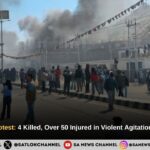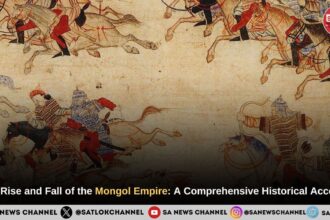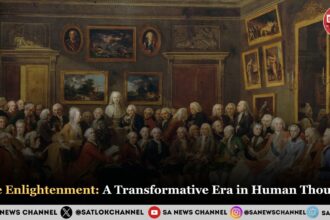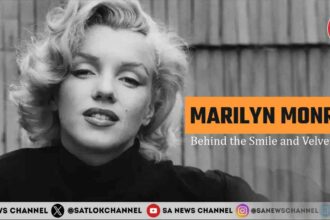How far would you go for an idea? Would you risk life, liberty, and loved ones to remake a nation? Fidel Castro did—and in doing so, became one of the most polarizing figures of the 20th century. His life was a battlefield of ideals, power, and contradictions that still echo around the world. “‘A revolution is not a bed of roses”, he once said.
- Early Years: From Privileged Childhood to Political Awareness (1926–1945)
- University Awakening: The Birth of a Revolutionary (1945–1952)
- The Path to Revolution: Moncada Barracks and Exile (1953–1958)
- Prison Years and Intellectual Development (1953-1955)
- Triumph and the Socialist Turn: Overthrowing Batista (1959)
- Building Socialism: Economic Transformation and Challenges (1963–1991)
- The Dark Side: Human Rights Violations and Political Repression
- The Global Revolutionary: Cuba on the World Stage
- The Special Period: Surviving the Soviet Collapse (1991-2000s)
- Personal Life and Relationships
- The Final Years and Transfer of Power (2006-2016)
- Social Achievements: Education, Healthcare, and Human Development
- Advancing Women’s Rights and Racial Equality in Cuba
- Legacy and Global Impact: Revered and Reviled
- The Enduring Questions: Revolution, Ideology, and Human Freedom
- When Earthly Leaders Fail: A Spiritual Answer to a Worldly Problem
- FAQs on Fidel Castro
In this article, we explore the remarkable biography of Fidel Alejandro Castro Ruz, a man whose story reads like an epic novel: a tale of revolution, ideological transformation, international intrigue, and profound contradictions that continue to shape global discourse decades after his death.
Early Years: From Privileged Childhood to Political Awareness (1926–1945)
Fidel Castro was born on August 13, 1926, the illegitimate son of a wealthy sugarcane farmer in Birán, Cuba. His early life was marked by a striking contrast between privilege and exposure to the harsh poverty experienced by the rural laborers on his father’s farm. Sent to Jesuit boarding schools, he became known for his sharp intellect and rebellious nature. These formative years were crucial in shaping his worldview, as he grew increasingly aware of the social and economic injustices plaguing Cuba.
Castro’s father, Ángel Castro, had migrated to Cuba from Galicia, Spain, after fighting for the Spanish in the Cuban War of Independence. He established a prosperous sugar plantation that conducted extensive business with the American-owned United Fruit Company, representing the foreign economic influence his son would later oppose.
University Awakening: The Birth of a Revolutionary (1945–1952)
Castro’s transformation from privileged youth to revolutionary began at the University of Havana, where he enrolled in law school in 1945. The university was a hotbed of political activism and violent gang culture, providing Castro with his first taste of revolutionary politics.
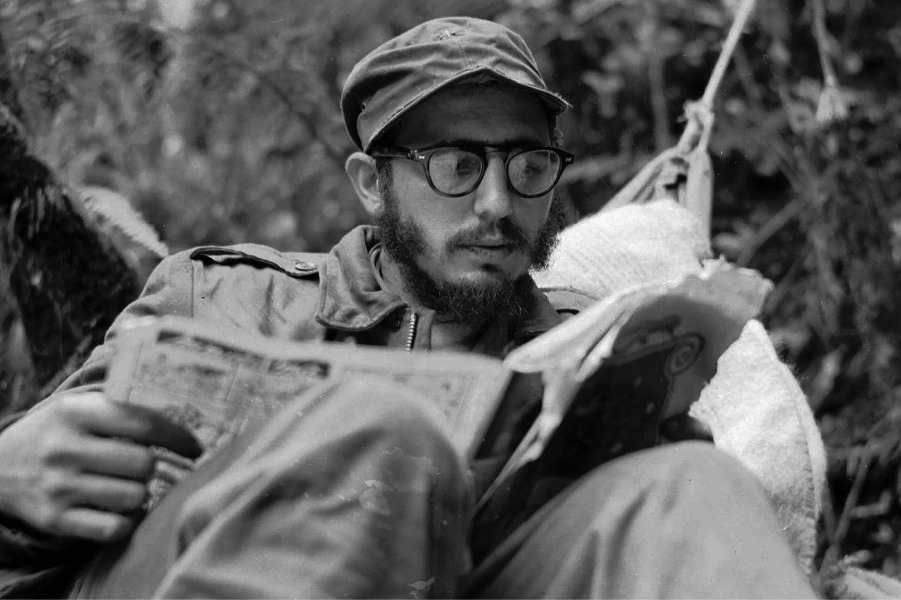
During this period, Castro joined the Party of the Cuban People (Partido Ortodoxo), which advocated for clean government and social justice. His involvement in student politics, including a failed attempt to overthrow Dominican dictator Rafael Trujillo in 1947 and participation in the violent Bogotazo riots in Colombia in 1948, demonstrated his early commitment to armed struggle as a means of political change.
The turning point came in 1952, when former president Fulgencio Batista seized power in a military coup, canceling the elections in which Castro was a candidate. For Castro, this was the final proof that armed struggle was inevitable.
The Path to Revolution: Moncada Barracks and Exile (1953–1958)
On July 26, 1953, Fidel Castro led a small, ill-equipped group of rebels in a daring attack on the Moncada Barracks in Santiago de Cuba. The assault was a catastrophic failure. Most of the attackers were killed, and Castro was captured. But defeat handed him his greatest stage.
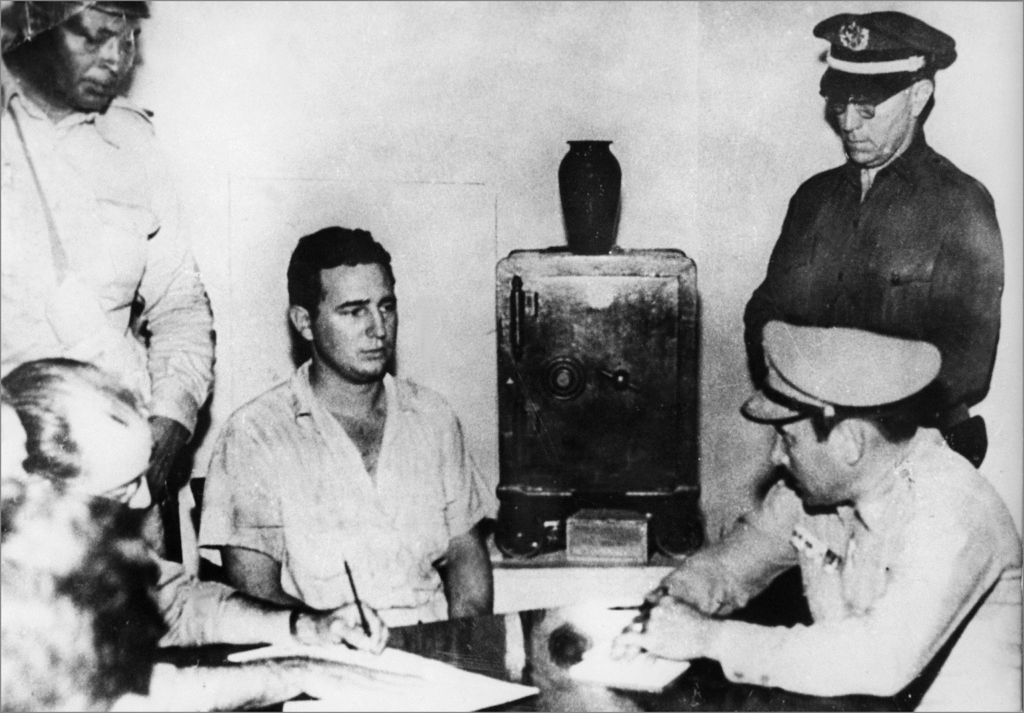
(Image: Fidel Castro under arrest and writing during interrogation after the failed Moncada Barracks attack in 1953.)
At his trial, he turned his defense into a blistering indictment of the Batista regime. His four-hour speech, concluding with the immortal words, “Condemn me, it does not matter. History will absolve me,” became the manifesto of his revolution.
After being granted amnesty in 1955, Castro went into exile in Mexico. There, he founded the 26th of July Movement and met a man who would become his most famous comrade: Argentine doctor Ernesto “Che” Guevara. Together, with 80 other revolutionaries, they boarded a leaky yacht, the Granma, and set sail for Cuba in December 1956 to start a war.
From the rugged wilderness of the Sierra Maestra mountains, Castro waged a brilliant guerrilla campaign, mastering not just military tactics but also propaganda to win the hearts and minds of Cuba’s rural poor.
Prison Years and Intellectual Development (1953-1955)
Castro’s imprisonment on the Isle of Pines proved pivotal in his ideological development. During his nearly two years in custody, he voraciously read Marx’s “Capital” and engaged in extensive correspondence with sympathizers, particularly Natalia “Naty” Revuelta⁷. Hansen’s groundbreaking research, based on unprecedented access to Castro’s prison letters, reveals how his socialist ideology crystallized during this period⁸.
At his trial, he turned his defense into a blistering indictment of the Batista regime. His four-hour speech, concluding with the immortal words, “Condemn me, it does not matter. History will absolve me,” became the manifesto of his revolution.
After being granted amnesty in 1955, Castro went into exile in Mexico. There, he founded the 26th of July Movement and met a man who would become his most famous comrade: Argentine doctor Ernesto “Che” Guevara. Together, with 80 other revolutionaries, they boarded a leaky yacht, the Granma, and set sail for Cuba in December 1956 to start a war.
From the rugged wilderness of the Sierra Maestra mountains, Castro waged a brilliant guerrilla campaign, mastering not just military tactics but also propaganda to win the hearts and minds of Cuba’s rural poor. Julia Sweig’s research, based on classified 26th of July Movement records, reveals that Castro’s final revolutionary force numbered only around 800 guerrillas against Batista’s 30,000-man army
Triumph and the Socialist Turn: Overthrowing Batista (1959)
On January 8, 1959, Fidel Castro entered Havana a triumphant hero. Cheering crowds swarmed the streets, celebrating the end of the Batista dictatorship and the dawn of a new era. Castro, a master of communication, used television and mass rallies to forge a powerful, direct bond with the Cuban people.
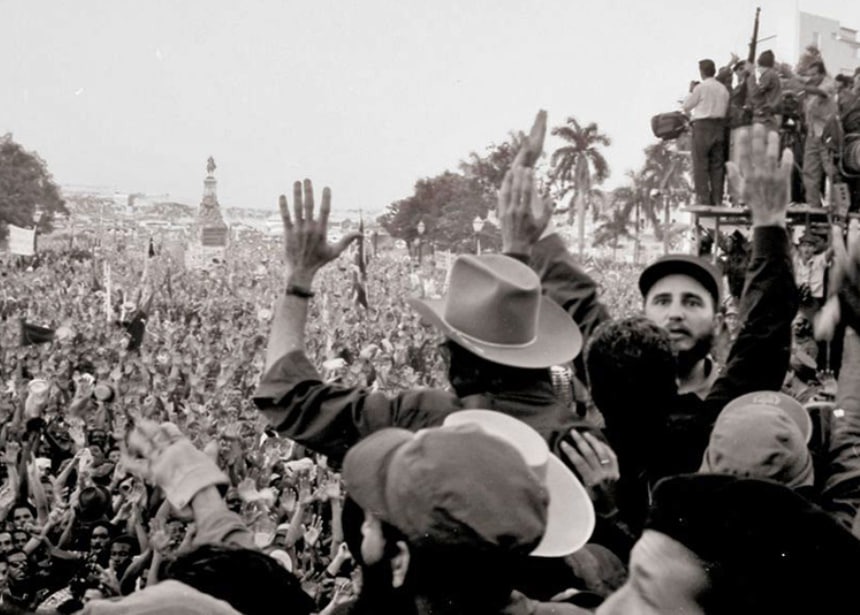
Initially, he denied being a communist, but his actions spoke louder than words. The First Agrarian Reform Law of 1959 seized vast land holdings, many of them American-owned, and redistributed them to peasants. He nationalized foreign businesses, banks, and industries, setting Cuba on a collision course with the United States. This led to two pivotal confrontations:
The Bay of Pigs Invasion (April 1961)
A CIA-backed invasion by Cuban exiles was crushed in less than three days. The failed attack was a humiliation for the U.S. and a massive propaganda victory for Castro. It galvanized support for his government and pushed him irrevocably into the arms of the Soviet Union. Shortly after, he publicly declared Cuba a socialist state.
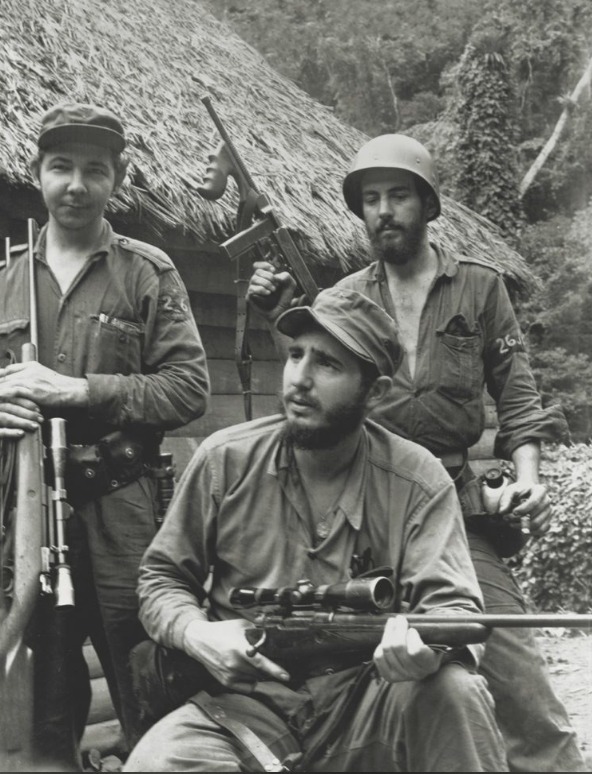
Revolution led by Fidel Castro)
The Cuban Missile Crisis (October 1962)
When the U.S. discovered Soviet nuclear missiles in Cuba, the world held its breath for 13 days, teetering on the brink of nuclear war. Castro, feeling his revolution was under existential threat, reportedly urged Soviet Premier Khrushchev to launch a preemptive nuclear strike on the U.S. The peaceful resolution of the crisis, negotiated between Kennedy and Khrushchev without consulting Castro, left him feeling like a pawn in a superpower chess game.
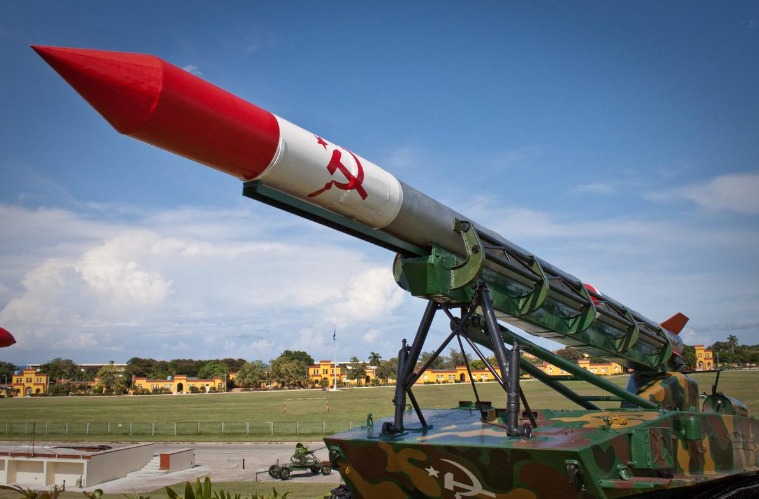
Building Socialism: Economic Transformation and Challenges (1963–1991)
With Soviet backing, Castro began constructing his vision of a socialist society. The Cuban Communist Party, officially founded in 1965 with Castro as First Secretary, became the sole political organization,
establishing a one-party state.
Economic Transformation and Challenges
The economic transformation of Cuba under Castro involved the near-total elimination of private enterprise and the adoption of central planning.
The Second Agrarian Reform Law of 1963 extended this effort by nationalizing much of the country’s agricultural land, eventually placing over 80% of farmland under state control. While these reforms addressed long-standing inequalities in land ownership, they also introduced persistent economic challenges that would affect Cuba throughout Castro’s rule.
Also Read: Qing Dynasty History: Expansion, Struggles, and the Last Chinese Empire
Cuba’s economy quickly became heavily dependent on Soviet subsidies, which provided essential support but also introduced significant vulnerabilities. In 1972, the island formally joined Comecon, the economic alliance of communist states, further tying its fortunes to the Soviet bloc.
Despite occasional attempts at diversification, Cuba remained largely reliant on sugar exports and Soviet aid throughout the 1970s and 1980s, leaving the economy vulnerable to external shocks and the eventual collapse of its main ally.
The Dark Side: Human Rights Violations and Political Repression
This progress came at a severe cost to liberty.
- The new government set up revolutionary tribunals to execute former Batista officials. Estimates suggest thousands were executed in the early years.
- A wide-reaching system of surveillance and repression touched every aspect of Cuban life. Political dissent was crushed. The Cuban Criminal Code’s “dangerousness” provision allowed authorities to imprison people for actions deemed contrary to “socialist morality,” even before a crime was committed.
- Independent journalists, activists, and opposition figures faced harassment, imprisonment, or exile, creating a climate of fear that suppressed criticism for decades.
The Global Revolutionary: Cuba on the World Stage
Castro’s ambitions were not confined to Cuba. He sought to export his revolution and position Cuba as a leader of the developing world.
Intervention in Africa
Castro’s most significant foreign intervention was in Angola. From 1975 to 1991, Cuba sent hundreds of thousands of soldiers to fight against South African-backed forces. Cuba’s role was decisive in securing Angolan independence and is credited by figures like Nelson Mandela as a key factor in the eventual downfall of Apartheid in South Africa.
Supporting Revolutions
Cuba actively supported leftist movements across Latin America, providing training and arms to guerrillas from Nicaragua to El Salvador.
Non-Aligned Movement
Castro became a prominent and powerful voice in the Non-Aligned Movement, an organization of states not formally aligned with or against any major power bloc. He used this platform to champion anti-imperialism and Third World solidarity.
The Special Period: Surviving the Soviet Collapse (1991-2000s)
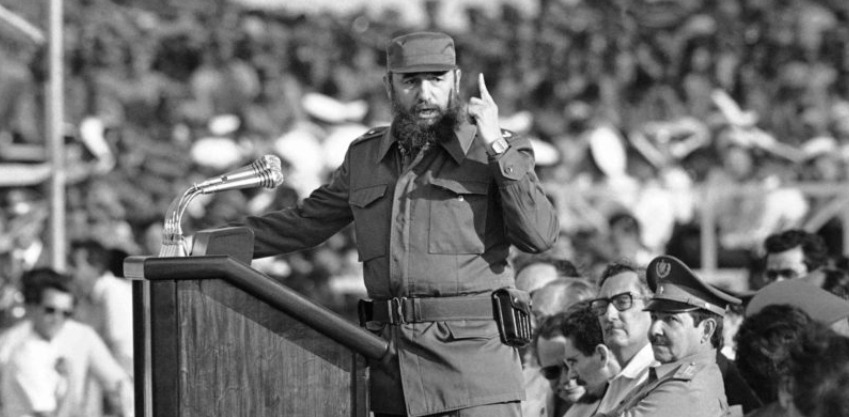
The collapse of the Soviet Union in 1991 was a catastrophic blow. Cuba lost its primary benefactor, and its economy imploded. This era, known as the “Special Period,” was marked by:
- Extreme Hardship: Severe shortages of food, fuel, and medicine led to widespread hunger and a dramatic decline in living standards.
- Reluctant Reforms: Faced with economic collapse, Castro was forced to make ideological concessions. He legalized the use of the U.S. dollar, allowed limited private enterprise (such as private restaurants called paladares), and opened Cuba up to mass international tourism to generate income. These changes saved the economy from total ruin but also introduced new social inequalities.
Personal Life and Relationships
Castro’s personal life remained largely secretive throughout his public career, reflecting his belief that family should be kept separate from politics. He was officially married just once, to Mirta Díaz-Balart in 1948, though the marriage ended in divorce in 1954 after Castro learned that his wife had accepted a government position under Batista.
His longest relationship was with Dalia Soto del Valle, a former schoolteacher whom he met during the 1961 literacy campaign. Together, they had five sons: Alexis, Alejandro, Angelito, Alexander, and Antonio; however, their relationship remained secret for decades. Castro also had children from other relationships, including a daughter, Alina Fernández, with Natalia “Naty” Revuelta, who eventually fled to Miami and became a critic of her father’s regime.
One of the most important relationships in Castro’s life was with Celia Sánchez, who served as his confidante and personal secretary until her death from cancer in 1980. Many historians consider her the most influential woman in Castro’s political life, though the exact nature of their relationship remains unclear.
The Final Years and Transfer of Power (2006-2016)
In July 2006, after undergoing emergency intestinal surgery, an ailing Fidel Castro provisionally transferred presidential duties to his younger brother, Raúl Castro.
The transfer became permanent in 2008 when Fidel officially resigned as president. Though no longer in power, he remained a powerful symbolic figure, writing columns titled “Reflections of Comrade Fidel” and occasionally meeting with world leaders.
Social Achievements: Education, Healthcare, and Human Development
Castro’s greatest and most undeniable triumphs were in human development, particularly in
education and healthcare.
- Education: The 1961 National Literacy Campaign was a monumental success. In just one year, an army of volunteer teachers reduced Cuba’s illiteracy rate from over 23% to just 3.9%. Education became free and universal, from kindergarten through university.
- Healthcare: Cuba built a world-class, free national healthcare system. Infant mortality plummeted from 60 deaths per 1,000 births before the revolution to one of the lowest rates in the world (4.3 by the 2000s). Life expectancy soared from 59 to 79 years asper some reports.
- Equality: The regime made significant strides in social equality. The Federation of Cuban Women championed gender rights, and the groundbreaking Family Code of 1975 legally mandated that men share in housework and childcare. Racial discrimination was outlawed, dramatically improving the social and economic standing of Afro-Cubans.
Advancing Women’s Rights and Racial Equality in Cuba
Castro’s Cuba made real progress in women’s rights and racial equality, areas where the country had been far behind before the revolution. The Federation of Cuban Women (FMC), set up in 1960, became a key force for change. By the 2000s, it represented over 86% of Cuban women, pushing for things like daycare centers, paid maternity leave, and equal pay for equal work.
The Family Code of 1975 went further, making it legally mandatory for men to share housework and childcare. It wasn’t easy to put into practice because of long-standing cultural habits, but it created a legal foundation for gender equality that was almost unmatched in Latin America at the time.
Castro also tackled racial discrimination, which had been widespread before the revolution. Laws banning discrimination were passed, and Afro-Cuban representation in government increased. While challenges remained, these steps improved the social and economic position of Cuba’s Black population and marked a significant change in Cuban society.
Legacy and Global Impact: Revered and Reviled
Fidel Castro’s death on November 25, 2016, at the age of 90, sparked global reflection on one of the 20th century’s most controversial figures. Reactions varied sharply across regions and political lines, highlighting the deep divisions his life and policies had generated.
In Latin America, many leaders celebrated Castro as a champion of independence and social justice. Former Brazilian president Luiz Inácio Lula da Silva called him “the greatest of all Latin Americans,” and other leftist leaders across the region mourned his passing. Even some critics acknowledged his influence in inspiring movements for social change throughout the developing world.
At the same time, Cuban exiles and human rights organizations underscored the authoritarian aspects of his rule and the human costs it entailed. The Miami Herald captured this perspective, noting that Castro “fired the hearts of the world’s restless youth” in his early years but had grown increasingly “irrelevant” in later decades.
The Enduring Questions: Revolution, Ideology, and Human Freedom
Fidel Castro’s life raises fundamental questions about revolution, ideology, and power that remain relevant today. Can revolutionary transformation occur without authoritarian methods? Is it possible to achieve social justice while maintaining political freedom? How should we weigh material improvements against restrictions on liberty?
Castro himself seemed aware of these contradictions. In a 2010 interview with Jeffrey Goldberg of The Atlantic, he reportedly admitted that, “The Cuban model doesn’t even work for us anymore.”
Yet Castro’s impact extends far beyond Cuba’s shores. His life story from a privileged youth to revolutionary leader to global icon continues to inspire and provoke debate. Whether viewed as a liberator or dictator, visionary or tyrant, Fidel Castro undeniably shaped the political landscape of the late 20th century and left an indelible mark on world history.
When Earthly Leaders Fail: A Spiritual Answer to a Worldly Problem
Looking beyond politics, Castro’s life also reminds us of a deeper question about the human condition: Is there a solution to life’s suffering? It makes us ponder over the essence of life in general.
Throughout the evolution of mankind, We’ve come across several instances where we’re left in an awe seeking answers on “The existence of god”. While some completely brushed it off, the others made up a philosophically good-sounding answer to it.
However, deep down our souls continue to have that lingering feeling of the search of the true superior being, who’s responsible for the creation of this universe and taking care of us.
Many people sought spiritual answers from prominent religious leaders, but were often disappointed by misleading stories that, ironically, pushed them further from true spirituality. While people’s faith can be misguided, it cannot be completely erased. In the past, the vulnerable and uneducated relied on these gurus for guidance, yet their practices brought no relief to those suffering the most.
In response to this dilemma, the spiritual teachings of Jagatguru Tatvdarshi Sant Rampal Ji Maharaj offer profound insight. He explains that humanity’s greatest achievements are part of a divine plan by the Supreme God Kabir to make eternal knowledge universally accessible.
In a world full of guides who lack true spiritual knowledge, Saint Rampal Ji Maharaj presents a clear, straightforward path of worship based on holy scriptures, revealing the way to the immortal land, Satlok.
Every aspect of the knowledge given by Saint Rampal Ji Maharaj is designed to purify the soul and is validated by proofs from the world’s holy texts. His mission is to lead humanity toward true spirituality, fostering a better world free from corruption, greed, and other malpractices, thereby aiding in the development of a just society.
To get deeper into the details, Must watch this video on the “Creation of Universe” completely authentic and backed by our scriptures! 🔽
FAQs on Fidel Castro
1. Who was Fidel Castro?
Fidel Castro was a Cuban revolutionary and politician who governed the Republic of Cuba as Prime Minister from 1959 to 1976 and then as President from 1976 to 2008. He transformed Cuba into a one-party socialist state under Communist Party rule, becoming a central figure in the Cold War.
2. What was the significance of the Moncada Barracks attack?
The 1953 attack on the Moncada Barracks was Castro’s first armed assault against the Batista regime. Although a military failure, his subsequent trial and famous “History will absolve me” speech turned him into a national figure and became the manifesto for his revolution.
3. What were Fidel Castro’s biggest social achievements in Cuba?
Castro’s government is widely recognized for its achievements in social development. His administration implemented a successful national literacy campaign and created free, universal healthcare and education systems, dramatically improving life expectancy and literacy rates across the country.
4. Why is Fidel Castro considered a controversial figure?
Castro is controversial due to the authoritarian nature of his rule. While he brought social progress, his government also suppressed political dissent, executed opponents, imprisoned activists, and restricted personal freedoms, leading to accusations of widespread human rights violations.
5. How did Cuba survive after the Soviet Union collapsed?
After the Soviet Union’s collapse in 1991, Cuba lost its main economic benefactor, leading to an era of extreme hardship called the “Special Period.” To survive, Castro’s government introduced reluctant capitalist reforms, such as legalizing the U.S. dollar and opening up to international tourism.




